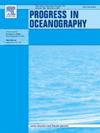The climatology of the deep particle flux in the oligotrophic western North Atlantic gyre, 1978–2022
IF 3.6
3区 地球科学
Q1 OCEANOGRAPHY
引用次数: 0
Abstract
The oceanic particle flux controls, in part, ocean biogeochemical cycles and long-term carbon sequestration. The Oceanic Flux Program (OFP), the longest running time series of its kind, has continuously measured the deep particle flux in the oligotrophic Sargasso Sea southeast of Bermuda since 1978. This paper describes the deep flux climatology at the OFP site over the 1978–2022 time period. Mass flux at 500 m, 1500 m and 3200 m depths has averaged 27.2, 34.8 and 36.8 mg m−2 d-1, respectively. Carbonates comprise ∼ 60 % of the flux, with lesser amounts of organic matter, opal and lithogenics. Flux magnitude and composition vary seasonally with large interannual variability, particularly in the winter/spring flux maximum. Flux frequency distributions are strongly skewed, especially at 500 m depth where flux magnitude and compositional variability are highest. Flux seasonality, skewness and compositional heterogeneity decrease markedly with depth. A significant component of the deep flux is sourced from large particle production in the deep water column (e.g. suspended material repackaging) rather than directly from the overlying export flux. Lithogenic flux increases five-fold between 500 m and 3200 m depths, underscoring the importance of deep lateral advection and lithogenic particle removal via particle cycling processes. Multidecadal averages in deep carbon fluxes are compared with concurrent monthly data on overlying net primary production (PP) and surface export flux (EF, measured by drifting traps at 150 m depth) at the nearby Bermuda Atlantic Time Series (BATS) site. Carbon fluxes are temporally coherent throughout the water column (within the sample resolution) and lag primary production by ∼ one month. Approximately 0.6 %, 0.5 % and 0.4 % of PP reaches the 500, 1500 and 3200 m depth horizons, respectively, with the highest depth penetration occurring during the Jan-Mar period of peak primary production. Annually, 7.6 % and 6.2 % of the EF reaches the1500 and 3200 m depth horizons, respectively, with the highest transfer efficiency (9.1 % and 7.4 %, respectively at 1500 and 3200 m depths) during the post-bloom (Apr-Jun) period. The OFP flux climatology summarized here provides an important baseline for assessing future consequences of a changing climate on ocean functioning in the oligotrophic North Atlantic gyre.
1978-2022年北大西洋西部少营养环流深部粒子通量的气候学
海洋颗粒通量在一定程度上控制着海洋生物地球化学循环和长期碳固存。海洋通量计划(OFP)是同类时间序列中运行时间最长的,自1978年以来连续测量了百慕大东南寡营养马尾藻海的深层颗粒通量。本文描述了1978-2022年期间OFP站点的深通量气候学。500 m、1500 m和3200 m深度的质量通量平均分别为27.2、34.8和36.8 mg m−2 d-1。碳酸盐占通量的约60%,有机质、蛋白石和岩性较少。通量的大小和组成随季节变化,年际变化较大,特别是在冬季/春季通量最大时。通量频率分布严重偏斜,特别是在500 m深度,那里的通量大小和成分变异性最高。通量季节性、偏度和成分异质性随深度显著降低。深层通量的一个重要组成部分来自深水柱的大颗粒生产(例如悬浮物质再包装),而不是直接来自上覆的出口通量。在500 m至3200 m深度之间,产岩通量增加了5倍,强调了深部横向平流和通过颗粒循环过程去除产岩颗粒的重要性。将深碳通量的多年代际平均值与附近百慕大大西洋时间序列(BATS)站点的上覆净初级生产量(PP)和地表出口通量(EF,由150米深的漂流捕集器测量)的同步月度数据进行了比较。碳通量在整个水柱中(在样品分辨率范围内)在时间上是一致的,并且滞后于初级生产约一个月。大约0.6%、0.5%和0.4%的PP分别到达500、1500和3200 m深度层,在1 - 3月的高峰初级生产期间,深度渗透率最高。每年,7.6%和6.2%的EF分别到达1500和3200 m深度,在开花后(4 - 6月)期间,传输效率最高(1500和3200 m深度分别为9.1%和7.4%)。这里总结的OFP通量气候学为评估气候变化对北大西洋少营养环流中海洋功能的未来影响提供了一个重要的基线。
本文章由计算机程序翻译,如有差异,请以英文原文为准。
求助全文
约1分钟内获得全文
求助全文
来源期刊

Progress in Oceanography
地学-海洋学
CiteScore
7.20
自引率
4.90%
发文量
138
审稿时长
3 months
期刊介绍:
Progress in Oceanography publishes the longer, more comprehensive papers that most oceanographers feel are necessary, on occasion, to do justice to their work. Contributions are generally either a review of an aspect of oceanography or a treatise on an expanding oceanographic subject. The articles cover the entire spectrum of disciplines within the science of oceanography. Occasionally volumes are devoted to collections of papers and conference proceedings of exceptional interest. Essential reading for all oceanographers.
 求助内容:
求助内容: 应助结果提醒方式:
应助结果提醒方式:


